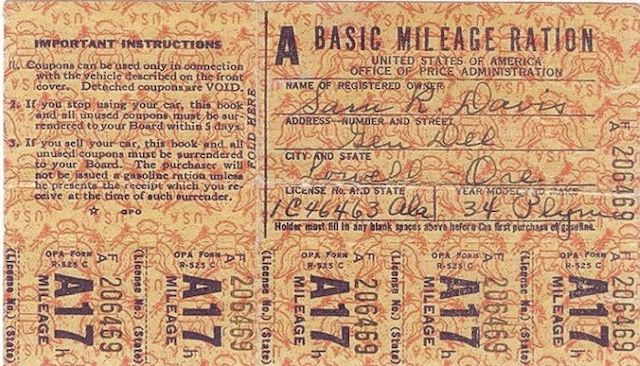Monday’s Antiplanner noted that Oxford England has set a goal of reducing driving by 25 percent and observed that, “No city in the developed world has been able to reduce driving by this much since World War II.” I didn’t want to give anyone any ideas, so I didn’t add that driving fell during World War II due to gas rationing.
A rationing coupon issued to a resident of Lowell, Oregon, who owned a 1934 Plymouth.
Too late: when I wrote that, I wasn’t aware that, just the day before, a journal called Ethics, Policy and the Environment had published an article arguing in favor of gas rationing to reduce greenhouse gas emissions. The authors claim that this would be a “fairer way to fight climate change.”
“Some argue for the modernisation of rationing, introducing tradable allowances,” the authors add, but “we argue that the rejection of markets, and a commitment to fair shares, is a key part of the value of rationing, and precisely what made rationing attractive to the public in the 1940s.” In other words, the authors believe that markets are inherently unfair. They might not think so if they knew how rationing worked during the war.
In the United States, people were grouped into one of several categories. Truck drivers, taxi drivers, police, doctors, ministers, anyone engaged in “official government business,” politicians, and other “important people” were given unlimited amounts of gasoline. Factory workers and traveling salesmen were allotted 8 gallons of gasoline a week. Anyone who didn’t fall into one of those groups was allowed only 3 gallons of gasoline per week. (The original rules started on page 3482 of the Federal Register for May 12, 1942.)
Far from being “attractive to the public in the 1940s,” many people saw these groupings as highly unfair. Why were politicians exempt? How many wealthy people used their political connections to get themselves exempted? Why were office workers who weren’t deemed “essential” allowed only 3 gallons? Why were ruralites who lived in large states, such as Montana or Wyoming where distances to and between towns might be great, limited to about the same rations as urbanites in small states such as New Jersey and Massachusetts?
These rules weren’t democratically decided but were imposed by an executive order by President Roosevelt. The authors of the Ethics article imagine that the distribution of coupons would be completely “equitable,” whatever that means, but any system whose rules would be written by politicians would end up being politicized. This is another way of saying that the powerful would get more and the powerless would get less. As the authors envision the system, no one would be allowed to sell coupons they didn’t need to someone who might be desperate for them, so all such inequities would be locked into the system from day one.
During World War II, people responded to the inequities by resorting to black markets. There wasn’t really a shortage of gasoline; instead, gas rationing was used to limit the consumption of rubber, which was in short supply. But with no real fuel shortage, it was easy for many people to by-pass the rationing system. Since there is no fuel shortage today, and the purpose of rationing would be to limit emissions, such black markets would quickly spring up.
As usual, the people advocating these kinds of ideas are ignorant of transportation realities. “Rationing petrol could encourage greater use of, and investment in, low carbon public transport, such as railways and local trams,” says one of the authors (who are from the University of Leeds in England). I don’t have data from England, but in the United States, public transport is a much bigger source of carbon, for every passenger-mile it carries, than automobiles.
In any case, you can expect that when things like the 15-minute city, bike paths, and light rail fail to reduce driving, climate alarmists are going to begin advocating for gas rationing.









Wonder how much gas would be consumed (and therefore concentrated emissions generated) while the plebians are forced to wait in gas lines as a result of ever ignorant urban planners.
The issue of traffic and convenience is spacing and design. Cities built before the 20th century….. accommodated the automobile but physical constraints mitigated heavy auto use and fed up residents made biking, walking and alternatives options.
Cities built post-war…cars were not just easily adopted….but widely segregated that walking, bikes were deemed unsafe or in the realm of Loser-dom. My coworker was just hit by a car. Whilst biking…..Post World War II the US adopted the “Dead Worm” neighborhood concept, that relegates neighborhoods to move via only one road. A dead end, begins on a feed road which feeds the highway. With only one way out, you have only one way to get anywhere.
Single family homes aren’t the issue, businesses aren’t the issue. Land layout….
Sprawl vs. Traditional neighborhood,
Post war resembles FrankGehry insane seizure drawings.
Traditional has the efficiency of a circuit board. And was developed Thousands of years ago.
Continued
http://groveland-fl.gov/ImageRepository/Document?documentId=4790